Heaven's Strings (Jintishi Poetry) Poem by Marieta Maglas
Heaven's Strings (Jintishi Poetry)
This time around...hush...the white fir
is the Christmas tree, song of faith~
not the song of the bird that flew away
from him last fall to warmer climes.
He carries that song with him and
can still feel its vibration.
Doesn't grow, but turns to blade death.
Christ took our sins upon Himself on this tree.
It's about the cross, yes, but
it's also about the winged white angels.
Now, ''in Him, we live and move''.
This fir holds the wood's silence,
while our songs soar to the upper skies.
Poem by Marieta Maglas
Tuesday, December 16, 2014
Topic(s) of this poem: songs
POET'S NOTES ABOUT THE POEM
Notes: Jintishi, literally 'Modern Poetry', was actually composed from the 5th century onwards and is considered to have been fully developed by the early Tang dynasty. The works were principally written in five- and seven-character lines and involve constrained tone patterns, intended to balance the four tones of Middle Chinese within each couplet. The principal forms are the four-line jueju, the eight-line lüshi, and the unlimited pailü. In addition to the tonal patterns, lüshi and pailü were usually understood to further require parallelism in their interior couplets: a theme developed in one couplet would be contrasted in the following one, usually by means of the same parts of speech.Regulated verse - also known as Jintishi (traditional Chinese: 近體詩; simplified Chinese: 近体诗; pinyin: jìntǐshī; Wade-Giles: chin-t'i shih; literally: 'modern-form poetry') - is a development within Classical Chinese poetry of the shi main formal type. Regulated verse is one of the most important of all Classical Chinese poetry types. Although often regarded as a Tang Dynasty innovation, the origin of regulated verse within the Classical Chinese poetic tradition is associated with Shen Yue (441-513) , based on his 'four tones and eight defects' theory [1] regarding tonality.[2] There are three types of regulated verse: the eight-lined lüshi, the four-lined jueju, and the linked couplets of indeterminate length pailu. All regulated verse forms are rhymed on the even lines, with one rhyme being used throughout the poem. Also, and definitionally, the tonal profile of the poem is controlled (that is, 'regulated') . Furthermore, semantic and tonal parallelism is generally required of certain interior couplets. During the Tang Dynasty, the 'Shen-Song' team of Shen Quanqi and Song Zhiwen greatly contributed to the development of this Classical Chinese verse form.The pattern of tonality within the poem is regulated according to certain fixed patterns of alternating level and deflected tones. Although there is some question as to the status of tone in older forms of Chinese, in Middle Chinese (characteristic of the Chinese of the Sui Dynasty, Tang Dynasty, and Song Dynasty) , a four tone system developed. For the purposes of regulated verse, the important distinction is between the level tone (similar to the modern Mandarin Chinese first tone) and the other three tones which are all classified in the category of deflected tones.The basic form of jintishi was the lüshi (律詩) , with eight lines. In addition to the tonal constraints, this form required parallelism between the lines in the second and third couplets. The lines in these couplets had to contain contrasting content, with the words in each line in the same grammatical relationship.Chinese poetic term which literally means 'modern-form poetry'. It refers to a regulated style of poetry which developed from the 5th century onwards and employed four tones: the level tone and three deflected tones (rising, falling and entering) . Tu Fu was the most accomplished exponent of jintishu.
READ THIS POEM IN OTHER LANGUAGES
This poem has not been translated into any other language yet.
I would like to translate this poem
Poems By Marieta Maglas
